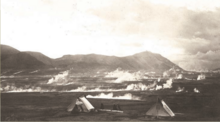
Back Valley of Ten Thousand Smokes German Vallée des Dix Mille Fumées French Tízezer Füst Völgye Hungarian Valle dei Diecimila Fumi Italian 1万本の煙の谷 Japanese Valley of Ten Thousand Smokes Dutch Долина десяти тысяч дымов Russian Долина Десяти тисяч димів Ukrainian 萬煙谷 Chinese


The Valley of Ten Thousand Smokes is a valley within Katmai National Park and Preserve in Alaska which is filled with ash flow from the eruption of Novarupta on June 6–8, 1912.[1] Following the eruption, thousands of fumaroles vented steam from the ash. Robert F. Griggs, who explored the volcano's aftermath for the National Geographic Society in 1916, gave the valley its name, saying that "the whole valley as far as the eye could reach was full of hundreds, no thousands—literally, tens of thousands—of smokes curling up from its fissured floor."
Prior to the eruption, the area now called the Valley of Ten Thousand Smokes was an unremarkable and unnamed portion of the Ukak River valley. Although never permanently inhabited by humans, it served as a pass for the Alutiiq people, as well as animals such as grizzly bears.[2][3]
The 1912 eruption was the largest eruption by volume in the 20th century, erupting a magma volume of about 13 cubic kilometers (3.1 cu mi). As many as 14 major earthquakes between 6 to 7, and over 100 earthquakes greater than 5, resulted from the collapse of the caldera at Mount Katmai and movement within the magmatic plumbing system.[4][5]


The ash-filled valley covers a 40-square-mile (100 km2) area.[6] The ash can be up to 700 feet (210 m) deep.[7] In places deep canyons have been cut by the River Lethe, allowing observers to see the ash flow strata. Since the ash has cooled, most of the fumaroles are now extinct and despite its name the valley is no longer filled with 'smoke' (i.e. steam).[6] Vegetation still does not grow in the valley.[8] The signs of volcanic activity are still visible on nearby hills.
Katmai's most recent eruption was in 1927, but there have been non-eruptive events as recently as 2003. The Alaska Volcano Observatory still monitors Katmai's activity as part of the Katmai Cluster, where there are five active stratovolcanos within 15 kilometers (9 mi) of Katmai.
Visitors to the valley most commonly arrive via bus along the 20-mile (32 km) road from Brooks Camp, which is the only road in Katmai Park. The valley is a source of creative exploration by photographers and naturalists.[9]
- ^ "Valley of Ten Thousand Smokes Tour". Katmai National Park & Preserve. National Park Service. August 28, 2008. Retrieved January 14, 2009.
- ^ "Valley of Ten Thousand Smokes and the 1912 Novarupta-Katmai Eruption - Katmai National Park & Preserve (U.S. National Park Service)". www.nps.gov. Retrieved October 27, 2017.
- ^ Bodry, Catherine. "The Valley of Ten Thousand Smokes". Retrieved October 27, 2017.
- ^ Hildreth, Wes; Firstein, Judy (2003). Geologic Map of the Katmai Volcanic Cluster, Katmai National Park, Alaska. USGS Geologic Investigations Series Pamphlet I-2778. pp. 15–16. DGGS 14836.
- ^ Hildreth, W.; Fierstein, J. (2012). The Novarupta-Katmai eruption of 1912- largest eruption of the twentieth century; centennial perspectives. Reston: USGS Professional Paper 1791. p. 135. DGGS 29955 Academia:47452498.
- ^ a b Scheffel, Richard L.; Wernet, Susan J., eds. (1980). Natural Wonders of the World. United States of America: Reader's Digest Association, Inc. p. 394. ISBN 0-89577-087-3.
- ^ "The Valley of Ten Thousand Smokes in Katmai National Park and Preserve | Alaska Historical Society". alaskahistoricalsociety.org. Retrieved October 27, 2017.
- ^ Harris, Ann G.; Tuttle, Esther; Tuttle, Sherwood D. (2004). Geology of National Parks. Kendall Hunt. ISBN 9780787299705.
- ^ Freeburg, Gary (2012). Valley of 10,000 Smokes: Revisiting the Alaskan Sublime (First ed.). Staunton, VA: George F. Thompson Publishing. ISBN 978-1-938086-03-8.
